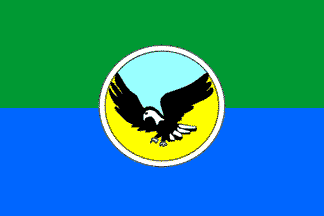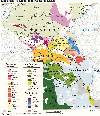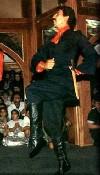| The
Lezgin people (Lezgian/Lezghi) |
Azerb.com
|
| |
|
 The
Lezgin are a Dagestani people numbering in total about 370.000. Of these
about 160.000 live in the Republic of Azerbaijan, on the north-eastern
zone, bordering the Russian Republic of Dagestan, in Qusar
and near Zindanmuruq, Shirvanovka, Laza and Maka. The rest of the Lezgin
population lives in southern Dagestan just across the Russian border.
The
Lezgin are a Dagestani people numbering in total about 370.000. Of these
about 160.000 live in the Republic of Azerbaijan, on the north-eastern
zone, bordering the Russian Republic of Dagestan, in Qusar
and near Zindanmuruq, Shirvanovka, Laza and Maka. The rest of the Lezgin
population lives in southern Dagestan just across the Russian border.
Most of the Lezgin live in the rugged mountain
regions where there are many, deep, isolated canyons and gorges. The summers
are hot and dry, while the winters are windy and brutally cold. Some live
near the Caspian Sea, where the winters are dry and mild.
 As
late as the mid-19th century, attempts were made to create a written script
for the Lezgin. In the 1920's, the Soviets changed the script from Arabic
to Latin. Then, in 1938, it was changed from Latin to Cyrillic. Russia
also attempted to replace all of the Arabic and Persian words with Russian
equivalents. Nevertheless, having their own written language only served
to unify, rather than Russianize, the Lezgin.
As
late as the mid-19th century, attempts were made to create a written script
for the Lezgin. In the 1920's, the Soviets changed the script from Arabic
to Latin. Then, in 1938, it was changed from Latin to Cyrillic. Russia
also attempted to replace all of the Arabic and Persian words with Russian
equivalents. Nevertheless, having their own written language only served
to unify, rather than Russianize, the Lezgin.
The Lezgin formerly lived in free societies
comprised of extended family units known as 'tukhum'. The societies were
patriarchal, and they were headed by male elders. These elders were responsible
for making all the major decisions concerning the clan. Today, because
of modernization and increased migration to the cities, the tukhum have
lost a lot of their importance.
 Most
Lezgin marry within their own clans, and the elder women are very influential
in such decisions. The custom of paying 'kalim' (bride price) is still
followed by some, but is now more of a symbolic payment than a requirement.
Most
Lezgin marry within their own clans, and the elder women are very influential
in such decisions. The custom of paying 'kalim' (bride price) is still
followed by some, but is now more of a symbolic payment than a requirement.
The Lezgin women are famous throughout
the Caucasus for their woven carpets. These fine carpets can easily be
recognized by their geometrical designs. The economy of the region is primarily
based on food processing (meat, cheese, butter), leather working, and textile
production. Many of the Lezgin have also found seasonal metalwork (making
weapons and jewellery) in the coastal towns of Dagestan and northern Azerbaijan,
especially in and around Baku. This has placed them under strong Azeri
influence and as a result, most Lezgin are now bilingual, speaking both
Lezgin and Azeri.
The 'lezginka' is the traditional folk
dance of the Lezgin. It is both a couples' dance and a male solo dance,
often performed with a sword. The man, imitating an eagle, falls to his
knees, leaps up, and dances with precise steps and strong arm and body
movements. When the dance is performed in pairs, couples do not touch;
the woman dances quietly as she watches the man's performance.
Arab muslims have strongly influenced the
Lezgin since the 9th century. By the end of the 18th century, the Lezgin
had been converted to Islam. This was credited to the systematic activities
of the 'tariqa', a semi-secret Sufi brotherhood, that later organized underground
Islamic schools and prayer houses during the years of Soviet rule. Today
hundreds of mosques are to be found in both Azerbaijan and Dagestan.
Although the Lezgin are Sunni Muslims,
there is a strong Shia minority. Both groups mingle many animist superstitions
with Islamic practices. For example the names of many pagan deities have
become synonymous with Allah, and they still practice ancient rituals connected
with spring planting and autumn harvesting seasons. They also make journeys
to local pilgrimage sites that predate Islam; and also believe that animal
bones have magical and healing powers.
In recent years a movement is emerging
which has made repeated calls for the creation of 'Lezginistan',
but still has very limited support. An independentist organization named
Sadval
(unioun) staged some public acts and claimed responsibility for the 1994
bomb blast in the Baku metro, but has fallen into oblivience recently.
Most sources agree it was foreign sponsored.
sources: multimap, bethany,
FOTW
| A to Z of Azerbaijan
/ A dan Z ye Azerbaycan |
www.azerb.com
|
 As
late as the mid-19th century, attempts were made to create a written script
for the Lezgin. In the 1920's, the Soviets changed the script from Arabic
to Latin. Then, in 1938, it was changed from Latin to Cyrillic. Russia
also attempted to replace all of the Arabic and Persian words with Russian
equivalents. Nevertheless, having their own written language only served
to unify, rather than Russianize, the Lezgin.
As
late as the mid-19th century, attempts were made to create a written script
for the Lezgin. In the 1920's, the Soviets changed the script from Arabic
to Latin. Then, in 1938, it was changed from Latin to Cyrillic. Russia
also attempted to replace all of the Arabic and Persian words with Russian
equivalents. Nevertheless, having their own written language only served
to unify, rather than Russianize, the Lezgin.
 The
Lezgin are a Dagestani people numbering in total about 370.000. Of these
about 160.000 live in the Republic of Azerbaijan, on the north-eastern
zone, bordering the Russian Republic of Dagestan, in Qusar
and near Zindanmuruq, Shirvanovka, Laza and Maka. The rest of the Lezgin
population lives in southern Dagestan just across the Russian border.
The
Lezgin are a Dagestani people numbering in total about 370.000. Of these
about 160.000 live in the Republic of Azerbaijan, on the north-eastern
zone, bordering the Russian Republic of Dagestan, in Qusar
and near Zindanmuruq, Shirvanovka, Laza and Maka. The rest of the Lezgin
population lives in southern Dagestan just across the Russian border.
 Most
Lezgin marry within their own clans, and the elder women are very influential
in such decisions. The custom of paying 'kalim' (bride price) is still
followed by some, but is now more of a symbolic payment than a requirement.
Most
Lezgin marry within their own clans, and the elder women are very influential
in such decisions. The custom of paying 'kalim' (bride price) is still
followed by some, but is now more of a symbolic payment than a requirement.